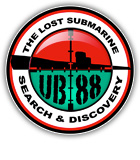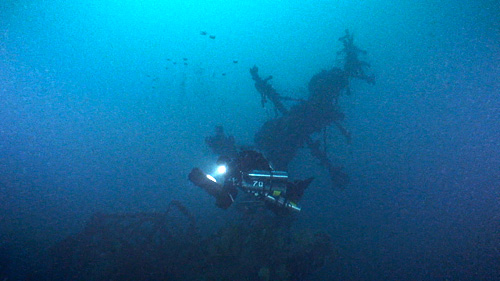
Kendall Raine at the base of the main mast of USS Vammen
(DE-644).
Photo by John Walker
USS Vammen (DE-644)
Buckley Class Destroyer Escort
Found off San Clemente Island
Dive Report
by Kendall Raine
Diving a newly discovered
wreck is a special feeling. When the wreck is deep and
remote, the thrill of adventure is that much greater.
On Sunday August 1, 2010, John Walker and I had just such
an opportunity. With the help of Scott Brooks, who
generously elected to give up his chance to dive the
wreck so he could act as our safety diver, we dove the
wreck of the USS Vammen (DE-644), a Buckley Class
Destroyer Escort which saw service in WWII, Korea and
Vietnam before ending her career as a target vessel off
San Clemente Island in 1971 as part of the Navy’s
Condor Missile testing program.
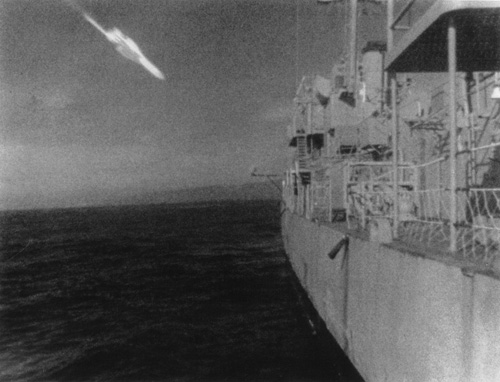
USS Vammen a millisecond before missile strike by Condor
AGM-53A (4-FEB-1971)
Official US Navy photograph by G. Edwards.
Photo courtesy of Capt. Billy J. Adams, SC, USNR, Retd
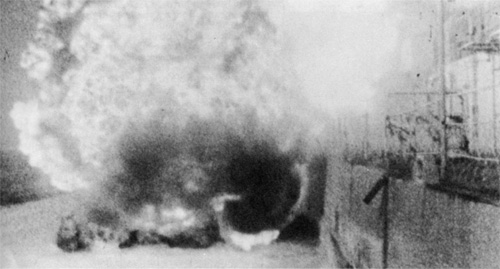
Explosion and fireball immediately after missile impact
(4-FEB-1971)
Official US Navy photograph by G. Edwards.
Photo courtesy of Paul Nitchman QM2 on USS Vammen
(1961-62)
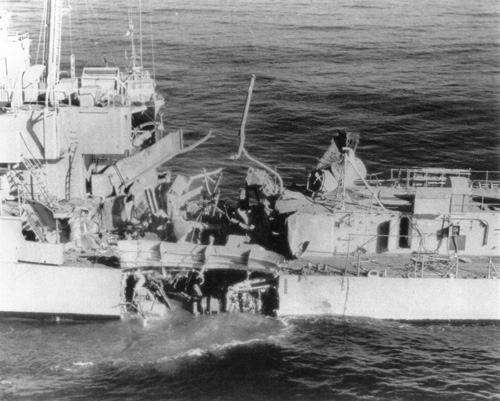
Damage inflicted to Vammen by Condor AGM-53A missile
strike (4-FEB-1971)
Official US Navy photograph by G. Edwards.
Photo courtesy of Capt. Billy J. Adams, SC, USNR, Retd
In December 2009, Gary Fabian located a possible wreck
site with the aid of multibeam sonar data for San
Clemente Island, CA. The following month Capt. Ray Arntz
confirmed the existence of a large wreck at this location
with side scan sonar. From Ray’s side scan images,
we knew the wreck was completely intact and upright. The
side scan indicated approximately 300-310 feet LOA with
superstructure and deck features clearly discernible.
Several months of archival research was required to
positively determine the identity of this ship. The
documentation is very specific and we believe without
question that the wreck is the USS Vammen. Physical
inspection of the site confirms the wreck as a Buckley
Class DE.
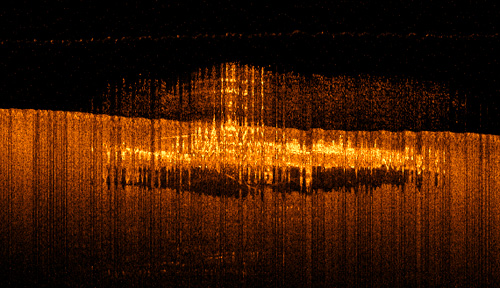
Side scan sonar image of USS Vammen (DE-644) at San
Clemente Island, CA. The ship is intact and upright on
the seabed. Her main mast can be seen protruding into the
water column indicating a list to starboard. Image by
Capt. Ray Arntz.
In a year where the weather has made offshore exploration
an exercise in frustration, we left Seal Beach on glass
smooth seas and averaged over 26 knots over to San
Clemente Island. The sun was poking its way through the
morning haze as we arrived on site. Despite green water
on top, we hoped for clear conditions at depth. Ray
dropped the down line and John and I geared up. There was
slight surface current running as we dropped into the
water and scootered over to the down line. Our descent
took about 4 minutes during which the visibility finally
opened up below 200 feet. Brown and white basket sponges
came into view about 40 feet above the wreck. As our
lights found the ship it exploded in the familiar
covering of pink corynactis and sponges on a base of
greenish brown encrustation. As usual, Ray put the down
line exactly where we asked him to-off the port side just
aft of amidships.
We came in at main deck level. I looked up and could see
superstructure silhouette against a featureless green
background. I banked left and motored half throttle at
deck level along the side of the ship. John scootered
inboard flying a couple of feet over the main deck. I
looked back over my shoulder and saw him cruising 15 feet
behind and to my right underneath overhanging features of
the superstructure. With his twin 35 watt lights attached
to the video mounted on the front of his scooter, it
looked like there was a car following me around.
Excellent. The dive was going exactly as planned; we were
dialed and in the groove. As we continued forward a large
section of the main deck disappeared revealing a massive
generator and interior features of the ship. We had
obviously found the entry point of the Condor missile.
The hull was blown away down to the water line and the
interior destruction testament to the power of the
ordnance. My guess is the missile went in just forward of
the single stack.
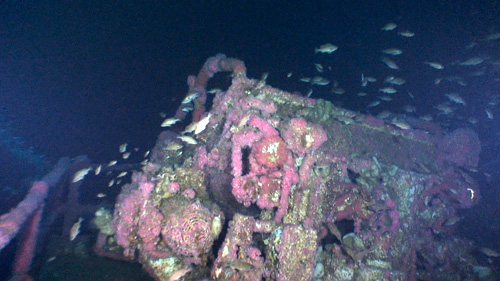
Port Hedgehog
Photo by John Walker
I cranked the scooter’s nose up and ascended the
forward edge of the impact area, riding up onto the deck
just below the bridge. Ahead of me was a large
rectangular box like structure I recognized as the port
side Hedgehog. The Hedgehogs were a mortar based ASW
system added to the vessel in exchange for its second
3”/50 gun mount. As I looked forward from the
Hedgehog platform I could see the forward 3" mount. The
main armament on the Buckley Class boats were 3
3”/50 caliber guns. These were unshrouded, as
opposed to guns on other DE, DD and larger class capital
ships. As with the USS Burns, the barrel and breach of
the gun was richly covered in corynactis.
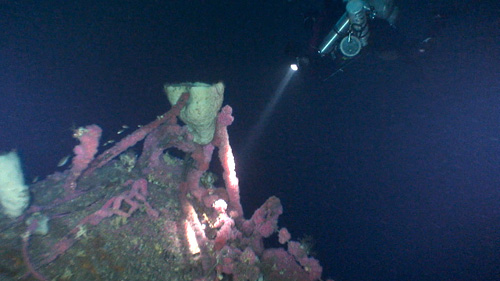
Kendall examines the bow of Vammen. Note the large barrel
sponge on the bow chock.
Photo by John Walker
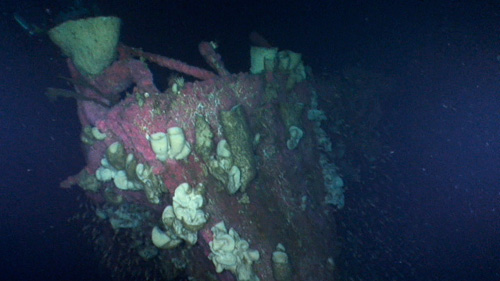
The razor thin bow of the Vammen looking aft.
Photo by John Walker
As I approached the bow, I was amazed to see a beautiful
large barrel sponge perched atop the railing at the very
tip of the bow. Perfectly symmetric, the sponge looked
like some kind of whimsical nautical adornment from the
days when warships still carried an element of artistic
expression in their design. The bow of a DE is razor
thin, and flying past the bow and turning around
presented an excellent view of the narrow beamed ship.
John was close behind so I moved out of the shot and
headed down the starboard rail back towards the bridge.
Climbing up the starboard side I flew past the bridge and
was amazed by the narrowness of the deck hatches. I knew
DE’s were compact, but clearly crew comfort was an
afterthought to Vammen’s designers.
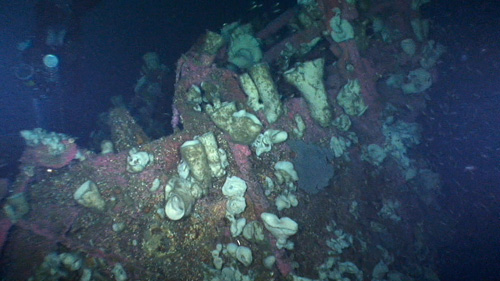
The stern of Vammen covered in corynactis and barrel
sponges.
Photo by John Walker
Heading aft, I flew along the deck looking for the triple
mid-ship mounted torpedo launchers. These I did not find
and it’s possible they were removed either as part
of a refit or simply in preparation of the vessel as a
target ship. I then dropped down to main deck level and
flew under the overhang of the starboard 40mm gun tub.
The fantail came up quickly as I flew through a thick
cloud of fish and out over the stern. Like the Burns, the
stern of Vammen is heavily encrusted and covered with
sponges. The ship’s rudders were visible below and
a large mooring chain extends down the stern and off into
the sand. As John flew by I headed forward again, up and
over the aft facing 3 inch gun and along the deck of the
port side. From the barrel of the aft facing gun sprouted
a pair of sponges- a perfect visual metaphor of the
transformation of Vammen from weapon to garden.
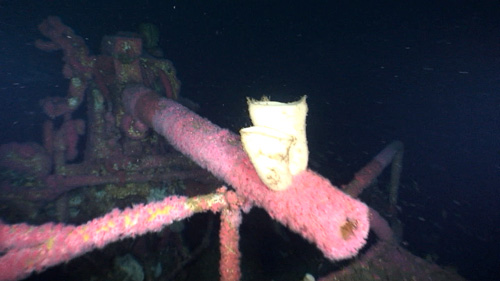
Vammen's aft 3"/50 caliber gun.
Photo by John Walker
Time came to complete our circuit. As I looked up for the
silhouette of the down line, I was treated to the outline
of the ship’s mast again, shrouded in fish and
back-lit against the light green of the shallower depths.
I scootered up and around the mast as John stayed low and
shot up. Figuring we’d passed the up line, we
headed aft again and found the poly pro line, starting
our ascent right at 15 minutes.
Scott met us at 70 feet with back-up deco gas and took
John’s scooter so he could get some video of both
of us hanging out. We then started handing Scott used
deco bottles. The water warmed up as the visibility
dropped from 70 feet to less than 20 and we wound up an
uneventful hang to complete our ascent into bright
sunshine and a light swell. Getting back aboard Sundiver
II was a breeze as our rigs were winched aboard and we
slithered onto the swim step.
USS Vammen Video by John Walker
